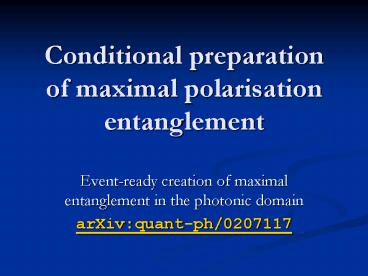Conditional preparation of maximal polarisation entanglement - PowerPoint PPT Presentation
1 / 20
Title:
Conditional preparation of maximal polarisation entanglement
Description:
... of maximal polarisation entanglement ... two polarisation modes of ... preparation of photon pairs in an entangled polarisation state is possible. ... – PowerPoint PPT presentation
Number of Views:67
Avg rating:3.0/5.0
Title: Conditional preparation of maximal polarisation entanglement
1
Conditional preparation of maximal polarisation
entanglement
- Event-ready creation of maximal entanglement in
the photonic domain - arXivquant-ph/0207117
2
Summary
- Applications of entanglement
- Down conversion light sources
- Random vs. Event-Ready
- Possible solutions
- Proposed experimental set-up
- How it works
- Fidelity vs. Efficiency trade-off
- Concluding remarks
3
Applications of entanglement
- Entanglement is an essential ingredient of
quantum computing. We need maximal entanglement
to implement the quantum information protocols - teleportation,
- dense coding,
- cryptography.
- It contradicts Bells inequalities and hidden
variable theories.
4
Linear Optics Quantum Computing
- In Linear Optics Quantum Computing, one qubit is
represented by a pair of photonic modes. - The qubit states are represented by a photon in
one of the two modes. - Example two polarisation modes of one beam. A
maximally entangled state of two qubits
corresponds to a pair of photons, one in each of
two beams, entangled in their polarisation states.
5
Down conversion sources of entangled photon pairs
the so calledtype-II phase matching configuration
- P. G. Kwiat et al., New high-intensity source of
polarization-entangled photons pairs, Phys. Rev.
Letters 75, 4337 (1995) - http//www.uebersetzung-reck.de/physics/entangled.
htm
6
Down conversion light sources a novel geometry
- P. G. Kwiat et al., Ultra-bright source of
polarization-entangled photons, Phys. Rev. A 60,
R737 (1999)
7
Random vs. Event-Ready
- Since down-conversion is a spontaneous process,
it occurs at random instants of time. A
difficulty arises How to operate on an entangled
pair until we are certain it is there? - An event-ready source of entangled pairs would
be one that provides a trigger signal to indicate
a success of the preparation process.
8
Possible solutions
- An event-ready source would be a good
substitute for a deterministic one. But how to
construct it? - The possible answers
- quantum non-demolition detection (QND),
- post-selection (not universal),
- entanglement-swapping,
- general conditional-detection schemes.
9
Post-selection
- In up-to-date experiments, the decision whether
an entangled photon pair had been produced was
deferred until the final detection of all the
photons. - This technique is known as post-selection.
- Implementing post-selection may require some
additional experimental means, like
single-photon-resolution detectors.
10
Entanglement swapping
- In the procedure of entanglement-swapping, two
crystals produce one photon pair each, and an
appropriate measurement on two of the photons
ascertains that the remaining two form an
entangled pair.
M. Zukowski et al., Event-ready-detectors Bell
experiment via entanglement swapping, Phys. Rev.
Letters 71, 4287 (1993)
11
Entanglement-swapping No-go
- But, as discovered later, it can not be detected
whether each crystal produced one photon pair, or
only one of the crystals produced both pairs. It
was even shown that no conditional detection
scheme utilising linear optics and
down-conversion crystals can produce maximal
entanglement from two down-converted pairs, i.e.
conditioned on detection of two auxiliary
detected photons.
12
General conditional detection
- It was, however, not known whether maximal
entanglement can be created by allowing for more
than two auxiliary detected photons.
P. Kok, S. Braunstein, Limitations on the
creation of maximal entanglement, Phys. Rev. A
62, 064301 (2000)
13
And the answer is
- Yes, conditional preparation of photon pairs in
an entangled polarisation state is possible. - The third-order of down-conversion is sufficient
(three pairs of photons need to be produced, four
of the produced photons are detected). - A simple experimental set-up is possible
consisting just of one down-conversion crystal,
linear optics and detectors.
14
We think
- Owing to the current progress in down-conversion
sources, this fact may be of practical importance.
15
Proposed experimental set-up
- PDC parametric down-conversion crystal
- a, b, spatial modes
- BS1, BS2 beam-splitters
- HWP half wave plate at 22.5
- PBS1, PBS2 polarisation analysers
- x, y polarisation modes
16
How it works
- the output is conditioned on fourth-fold
coincidence of detection - the coincidence is not possible in the first
order - the second order vacuum term vanishes due to
interference - the third order yields the maximal entanglement
17
Vanishing of the vacuum term
- All four photons must be reflected by the
beam-splitters for the coincidence to take place. - The second order down-conversion output is
- Only the middle term contributes to the
coincidence in the upper arm. The lower arm is
left in the state - No coincidence is possible in the lower arm.
18
Calculating the output state
- take the third order down-conversion term
- apply the linear optics transformation
- calculate a polynomial quotient
19
Fidelity vs. Efficiency trade-off
20
Fidelity vs. Efficiency trade-off
21
Concluding remarks
- The output state can be easily calculated in
terms of polynomials in the creation operators. - In case of non-ideal detection (non-unit
efficiency or lack of single-photon resolution),
both the fidelity of the output state and the
overall preparation efficiency are diminished. - The transmittance/reflectivity of the
beam-splitters can be adjusted to enhance
fidelity at the cost of decreased efficiency.































